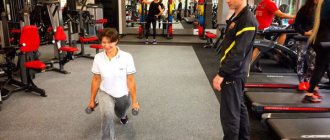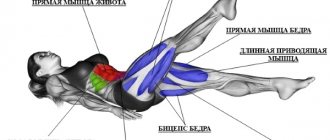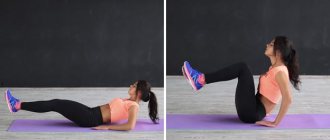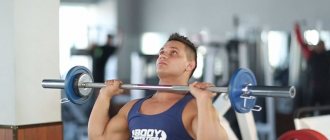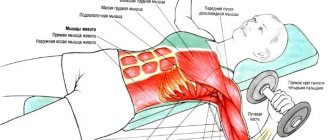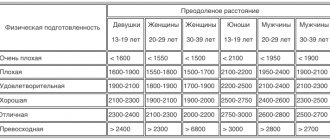You can diversify your workouts and make them universal for the gym and outside with a sonorous name - the farmer's walk. With its help, you can achieve a significant improvement in strength while simultaneously developing endurance. This exercise involves different muscle groups, so it can be used to strengthen the muscle corset and maintain body tone.
With all the advantages of the exercise, before including it in your training, you need to analyze its features and think about whether it is right for you or not. Therefore, in this article we will carefully consider which muscles work in the farmer’s walk and learn the correct technique for performing the exercise. We will also find out why such training is useful and whether it has contraindications.
How is exercise useful?
The Farmer's Walk is an exercise to develop core strength. By including it in your training and performing it regularly, you can talk about creating a natural muscular corset that supports the spine. As a result, there is beautiful posture and the opportunity to take the training process to a more professional level.
Continuing the conversation about the farmer's walk exercise, the benefits of which are undeniable, it should be noted that with the correct technique, it involves various muscle groups:
- muscles of the legs (hips, legs and feet) and arms;
- abdominal muscles (we recommend basic ones);
- shoulder girdle.
It is also important to note that the load is distributed evenly across these muscle groups. All muscles work, strengthening, complementing each other. After completing the exercise, regular walking, even long distances at a sporting pace, will seem like easy entertainment.
In addition, walking with weights allows you to:
- Develop endurance, grip strength and muscle corset.
- Enlarge the deltoid muscles.
- Effectively develop coordination of movements.
- Increase your calorie burn and move forward if you reach a training plateau.
- Perform the exercise in any conditions, if there are available tools that can replace dumbbells and weights.
Login to the site
Features of a farmer's walk with weights2016-04-01 10:16 RepoRteR
Farmer's Walk - Basic Option Take 2 kettlebells that are heavy enough for you. You should be able to maintain proper body position with them. With your chest raised, start walking forward (or in circles if the room is small). As you move, your breathing quickens, your heart works harder, and your grip weakens. In the end, two thoughts will remain: “just not to unclench my fingers” and “I wish I could take a couple more steps.” The single kettlebell farmer's walk, while seemingly easier, requires more muscle engagement to ensure your posture remains correct and you're walking in a straight line. Farmer's Walk with Kettlebells on the Chest (Photo 1) This variation, unlike the regular farmer's walk, gives the grip a break. The kettlebells will tend to drive your torso forward, and your hips and muscles will have to work to maintain stability. If you do it with 2 weights, the exercise becomes more complicated, because The weights will put pressure on the diaphragm, causing your breathing to become shorter and more ragged, muscle fatigue may set in faster, and you will have to work harder to complete the distance. Farmer's Walk with a Kettlebell Overhead (Photo 2) A way to strengthen the shoulder joints and improve the endurance of the surrounding muscles. Lift 1 or 2 weights to your chest, then press them overhead and step forward. Changing the direction of movement will give additional impetus to the core muscles. Farmer's walk with a kettlebell upside down (photo 3) Strengthened work on the muscles of the forearm and abs. A potentially dangerous feature of this position is that it is easier for the kettlebell to fall out of the hand when the grip weakens. Kettlebells can be placed either in the arms, bent at the elbows, or straightened up.
Source: Girevichka.ru
Training with a farmer's walk
2016-04-01 10:24 RepoRteR
The farmer's walk, which we talked about last time, is an exercise with its own specifics. A smart way to use it is to put a farmer's walk at the end of your workout. This is a full body exercise, but not too technically difficult. The finish of the workout might look like this: Distance: 50 meters Rest: 1-2 minutes between sets, no rest between exercises in a set Set 1 Basic farmer's walk with 2 kettlebells Basic farmer's walk with a kettlebell in the left hand Basic farmer's walk with a kettlebell in right hand Set 2 Farmer's Walk with 2 kettlebells on the chest Farmer's Walk with 1 kettlebell on the chest in the left hand Farmer's Walk with 1 kettlebell on the chest in the right hand Set 3 Farmer's Walk with 2 kettlebells overhead Farmer's walk with 1 kettlebell overhead in the left hand Farmer's walk with 1 kettlebell overhead in the right hand In principle, the exercise can also be used at the beginning of a workout to warm up - but then it is better to use not heavy weights, but 50 percent of those that you would taken at the end of training, when there is no point in saving strength. You can do the exercise either for time or distance. For example, 1 minute or 25-50 meters. As your strength increases, increase either the weight of the weights or the time or distance. Or you can not just use the farmer’s walk as a warm-up or finish, but build an entire workout on its basis. The weights should be heavy enough for you. For example, you can build a lesson this way: Farmer's walk - 50 meters Burpees - 10-15 times Farmer's walk - 50 meters Lying jumping jacks - 10-15 times Farmer's walk - 50 meters Bent rows * - 10 times Farmer's walk - 50 meters Chest raise + press* - 10-15 times *on each side Rest 3 minutes and repeat 2-3 more times.
Author: Larina Maria
Swings or jerks?
2016-04-01 11:24 RepoRteR
Kettlebell swings and jerks are very similar movements. There is even an expression: “A snatch is a swing that ends above your head.” It is clear that if you are seriously interested in kettlebells, then the snatch cannot but be in your program. And if you are not such a fan yet, the question may arise: which exercise should you concentrate on to achieve your goals? For example, swings would be more suitable for sprinters as an aid. This is where a comparative analysis from Pavel Tsatsouline comes in handy.
So, swings versus snatches: • Both exercises are excellent for developing power • Both are good for developing the upper back • Swings are more suitable for developing so-called strength.
“posterior chain” muscles and abs • Snatches burn more calories than swings (per 1 repetition with the same weight) • The snatch develops grip strength to a greater extent • Snatches are more demanding on the mobility of the thoracic spine and shoulders Overfatigue and overtraining
2016-04 -01 13:34 RepoRteR
Disorders of sleep, appetite, immunity or mood, one way or another related to training, are familiar to the vast majority of athletes. A complex of symptoms, distinguished by characteristic features, is periodically observed in both new and experienced gym visitors. Let's look at the development paths and methods of “treating” this condition.
Most often, overtraining vaguely refers to a condition caused by the predominance of destruction processes over recovery processes. When reading this phrase, muscle tissue and its training microdamages are visualized in the brain of a lover of strength sports, leading to the idea that it is the muscular system that underlies this condition. This is understandable - the image is familiar, but does not contain a clarification of the definition. Meanwhile, muscles are not the source of trouble; rather, they act as involuntary participants in the development of overtraining.
Who really doesn't have time to recover?
The correct answer to this question is: central nervous system.
The fact is that control of muscle contraction occurs along a chain of participants: nerve center - nerve fiber - muscle. The muscle is only the final performing organ. Meanwhile, the transfer of command itself requires costs. Experiments with electrical stimulation can easily show that fatigue develops in this chain in the same sequence. First, the nerve center gets tired (the area in the central nervous system that produces “orders” - guidance), then the nerve fiber gets tired and can no longer conduct the nerve impulse normally (the “signalmen” get tired), and only after that, the last thing, the muscle itself gets tired. The depletion of resources of the first two elements of this chain, which prevails over the restoration of their resources, causes a characteristic set of symptoms that most people call overtraining.
Is all overtraining overtraining?
Ask any person in a fitness club about what it means to deteriorate sleep, appetite, decreased immunity and bad mood during training loads. What do you think he will answer you? Surely he will say: “You just overtrained.” In fact, subjective sensations are a sign of overwork. Overtraining will develop later if you ignore these “bells”.
Overwork.
Usually this condition is characterized by subjective sensations that greatly ruin the life of a beginner or intermediate athlete. The most common are insomnia, increased fatigue, constant fatigue, disturbances in appetite and sleep. What is behind these symptoms? The inability of the nervous system to sufficiently restore the expended resources of nerve cells. Therefore, the symptoms characteristic at this stage are “nervous”. If at this stage the balance between the consumption and restoration of central nervous system resources does not normalize, overtraining actually occurs. Most trainees call overfatigue “overtraining” and urge it to be treated, first of all, with rest. And they turn out to be right: at this stage, almost any methods and means that either reduce the consumption of central nervous system resources (increasing the duration of rest, reducing the intensity and duration of training, avoiding stress) or speed up their recovery (improving the quality of nutrition and rest, using special supplements) are effective. )
Overtraining.
This is a condition that is characterized by physiological changes associated with the inability of the central nervous system to perform its functions normally. The complex of symptoms includes disturbances in the functioning of the cardiovascular system: pain in the heart, including tingling sensations, pain radiating to the arm, inadequate reactions of the cardiovascular system to physical activity, increased heart rate at rest, including after sleep. Signs of disorders in the central nervous system become much more pronounced; phobias (fear of illness, cancer, death), short temper, unstable mood, obsessive states (including a feeling of uselessness of training, lack of progress, etc.) may appear. True overtraining requires complex treatment, including medication, and the decision to “just rest” will not lead to a quick and complete recovery of the athlete. Often this condition requires medical supervision.
How to treat?
Now that the reader has figured out the root cause of the symptoms of fatigue and overtraining, we can move on to practical recommendations for the prevention and “treatment” of these conditions.
The initial stages can really be treated with rest. One of the most common causes of overwork is inadequately planned physical activity. This statement is also true for people who use doping - rapid muscle recovery misleads them and contributes to maintaining excessively high loads, which ultimately leads to the development of fatigue and overtraining. Therefore, competent planning of the training process, which implies a balance between high and low intensity, cycling of loads and assessment of long-term prospects, are the main means of prevention.
Remember that the resources of the nervous system are depleted not only by training. Illness and stress also contribute. Therefore, it would be very reasonable to take them into account when planning your load and not combine serious stress in everyday life with high training loads.
Nutrition, supplements, and pharmacological treatments for conditions.
The cells of the central nervous system are extremely sensitive to energy deficiency. Muscles, which also consume a large amount of energy substrates, can thereby contribute to the development of deficits in nerve cells when undernourished. Therefore, of course, the second recommendation after rest is normal nutrition. Without energy sources, restoration is impossible.
There are supplements and drugs that help increase the energy supply of nerve cells by increasing the efficiency of mitochondria. These include glutamic acid, antihypoxic and nootropic drugs.
You can start taking glutamic acid at the first subjective signs of fatigue. In addition to normalizing the condition of nerve cells, it also promotes anabolic processes in muscles, which is why it is a universal supplement in strength sports.
Antihypoxic drugs help cells restore energy reserves faster. In addition to improving the energy supply of nerve cells, their intake helps to increase tolerance to various types of physical activity.
Nootropic drugs enhance energy and anabolic processes in nerve cells.
The use of inhibitory mediators - substances that promote the development of inhibition processes of nerve cells and thereby help the cells recover, is also useful when signs of fatigue appear. This group includes glycine and GABA drugs (for example, Pantogam). Their use can also prevent the development of fatigue if your heavy training takes place against a background of stress. They will also help cope with insomnia and overexcitation.
When treating fatigue directly, other medications are also used, but their prescription is the prerogative of the doctor.
Author: Nika Musatova (ProStatus magazine)
Who should not do the farmer's walk?
Contraindications to performing a farmer's walk are:
- Lack of common sense and overestimation of one's own capabilities. There is no need to immediately grab heavy weights and try to go a long distance. In this exercise, it is important to gradually increase the weight of the weights and adhere to the technique (more on this later).
- The exercise is contraindicated for those with a weak back, scoliosis and other postural disorders. In this case, it is recommended to practice walking only after a strong muscle frame has been formed.
- The exercise is contraindicated in the acute stage of any chronic disease.
- Like any training, the exercise should not be practiced during an acute respiratory infection or when the body is weakened. It is better to postpone mastering the farmer's walk until you have fully recovered.
Execution technique
Proper technique for performing the Kettlebell Farmer's Walk is the key to a safe and productive workout.
How is the exercise performed?
Preparatory stage
- Determine how the exercise will be performed. With little weight for a long distance or with a lot of weight for a short distance.
- It is necessary to prepare the weight with which the exercise will be performed. The farmer's walk is equally effective with a barbell, dumbbells, or kettlebells. The recommended load weight depends on the physical characteristics of the athlete, the goals pursued during training and the length of the distance.
- Clear/prepare the area for excavation from barriers and obstacles.
The workout itself
Step 1.
We stand between the weights, which we first place in one line with our feet. The farmer's walk can be performed with two dumbbells or any other weight of equal weight in each hand.
Step 2.
We take the projectile in our hands, while watching our posture. Keep your back straight while lifting weights. When performing a squat, we bend a little and bring our shoulder blades together, raise our head and, while inhaling, lift the weight.
Step 3.
We move along the distance in small steps, gradually increasing the pace. We make sure that when the farmer walks with dumbbells or other weights, the shoulder blades are fixed and in their original position. Slightly raised shoulders can reduce the load on the shoulder joints.
When doing a farmer's walk, pay attention to the following key points:
- Retracted shoulder blades during the entire load;
- The head looks straight, the chin is raised;
- All movements (from lifting weights to walking) are smooth and springy.
The main mistake during a farmer's walk is rounded shoulders and back. The reason for this may be a weak muscle corset and incorrectly selected working weight. Performing an exercise with poor technique can result in injuries to the spine and shoulder joints.
When including weighted walking in your training program, always carefully select sports equipment and their weight, follow the correct technique for performing the exercise and take your time. Do not forget that any strength training directly affects the functioning of the ligamentous apparatus, and this can lead to injury. You can remove some of the load from the abdominal and spinal extensor muscles using a weightlifting belt. At the same time, careful adherence to the technique of performing the exercise is not canceled.
Learn how strength athletes develop overall strength and lay the foundation for maximum muscle growth and functionality.
Contents of the article: The topic of this article is the farmer's walk exercise. From it you can learn about the technique of performing the movement and get acquainted with various nuances. This exercise with an unusual name is familiar to most women, although they most often do not realize it. It so happens that it is women who most often visit stores, and when they carry two bags of groceries, this is where the similarity with the exercise we are considering today is observed.
Technique
The exercise uses various equipment:
- special beams with handles;
- trap rods;
- weights;
- unusual options: bags, buckets and even live pigs (yes, just like on a farm).
The farmer's walk is not performed with a loaded bar on the shoulders, as this creates a dangerous compressive load on the spine and can lead to a fall.
Trained athletes sometimes do a walk with one dumbbell in their hand. This technique allows you to specifically load the oblique abdominal muscles.
We recommend beginner athletes and girls to perform a farmer's walk with dumbbells. You need to choose the right weight so that the element has the necessary impact and does not cause harm. There are two ways to do this:
- Each dumbbell should equal 20% of the athlete's body weight.
- The athlete takes such equipment that he can hold while walking for 35–40 seconds.
Technique:
- Squat down and clasp the dumbbell bars with your palms.
- Keeping your back straight, rise up.
- Take short steps forward.
- After walking 30–40 meters, stop, turn around and repeat the passage.
Recommendations:
- When you squat behind dumbbells, maintain a bend in the lumbar region. This will protect you from injury when lifting heavy equipment.
- Don't lower your chin to your chest. Otherwise, after some time, the upper back will involuntarily “round out.”
- Do not place your feet wider than your shoulders, otherwise the dumbbells will touch your thighs. This will make it difficult to perform and may cause the projectile to fall.
- Bend your legs slightly as you move. Walking with straight limbs as a farmer puts dangerous stress on the knee joints.
- Keep your back vertical. Do not lean forward when moving, as this may cause you to fall.
- Avoid rocking. When moving with a “farmer’s” step, try to minimize the sideways tilt of your body.
For beginners and girls, we recommend using sports accessories: wrist straps to improve grip and a weightlifting belt to protect the lower back.
If you're working out at home, try doing a farmer's stair walk. To perform this, you will need light dumbbells (6–10 kg) or improvised items (for example, two two-liter bottles of water or two identical backpacks filled with books). Take a load in each hand, go out into the entrance and climb 5 steps up 3-4 floors. This way you can effectively load the muscles of your legs and buttocks.
Benefits of Farmer's Walk Exercise
Let us immediately note that the farmer’s walk exercise is basic, as it involves a large number of muscles.
Accordingly, the body’s response will be complex. The hip, knee joint, ankle, thoracic and lumbar spine, as well as the collarbone and shoulder blades are actively involved in the work. Here are the main advantages of this movement:
- Increases endurance.
- Leg muscles develop.
- The strength of the core muscles increases and the muscular corset of the spinal column is strengthened.
- The secretion of somatotropin accelerates.
- The amount of energy consumed increases.
- Coordination is developing.
- Can be done anywhere.
How to perform the Farmer's Walk exercise correctly?
This is a fairly simple exercise from a technical point of view, but it has some features.
To perform the exercise, a barbell equipped with handles is most often used. At the same time, you can use weights or dumbbells. Stand between the implements and, tensing your abdominal muscles while keeping your back straight, take them in your hands. By pushing your body up with your heels, you are in the starting position. Take short but quick steps and move in a straight line, using proper breathing. The distance for one walk is most often from 25 to 50 meters. Having reached the finish line of this distance, it is necessary to lower the sports equipment to the ground. After that, turn around and do everything again in the opposite direction. In one lesson you should perform from 5 to 10 such walks, without pausing between them.
Tips for athletes when performing the Farmer's Walk exercise
When going down for sports equipment, you need to perform a movement similar to a squat.
At the same time, you must ensure that your back remains straight. Use the weight of the weights that is determined by the formula - your body weight/4. For example, you weigh 80 kilograms, then the weight of each projectile should be 20 kilograms. Do not use long steps, but try to mince at a medium pace. It is also necessary to ensure that your shoulders do not round and your head is always directed forward. Probably, at first the farmer's walk exercise will be quite difficult for you, and in this case you can perform from 2 to 4 “walks” lasting 30 seconds. Gradually you will need to increase the number of sets and increase the weight of the equipment.
When scientists studied this exercise, they found that this is one of the best complex movements that can evenly load a large number of muscles. As a result, you not only improve your physical performance, but also expend more energy. Also note that the farmer's walk exercise is competitive in the Strongmen discipline.
This movement can be called safe. The only exception is if the athlete has scoliosis or weak back muscles. In this case, you first need to focus on strengthening the muscular frame of the spinal column and only then can you begin to perform this movement.
Also remember that using heavy weight will pull you forward, causing your back and shoulders to round. This can cause injury and you need to choose the right weight. We have already talked about how to do this above.
It should be admitted that most bodybuilders ignore this exercise or have not heard of it at all. They are sure that the farmer's walk exercise is completely useless and will not bring the desired result. This is a serious misconception, because if you follow all the technical nuances, you can effectively work out a large number of leg muscles and, as a result, achieve a strong hormonal response in the body.
This movement engages the muscles of the legs, back and shoulder girdle, which no other exercise can do. All this will lead to a powerful release of the male hormone. If you take long steps, this can cause severe overload on your joints and tendons. This may result in injury.
If you lower your head down, you will reduce the load on the trapezius, but on the contrary, you will increase the load on the spinal column. Look straight ahead and don't lower your head.
Mikhail Koklyaev performs the farmer's walk exercise in the following video:
One of the universal exercises that can be done with kettlebells, dumbbells, sandbags or anything else is called the farmer's walk.
. Its fundamental difference from other exercises with weights is the constant movement.
It is believed that moving under load (and the farmer's walk is one option) develops useful, applied strength throughout the body and improves overall physical condition.
Squats, presses, and deadlifts make you stronger, but at the same time, they are not all you need to achieve athleticism. In addition to strength, there is also coordination and, so to speak, “awareness of your body.” The Farmer's Walk helps develop not only strength, but also these qualities.
To be honest, I haven’t fully tried this exercise yet. I include it periodically in my workouts, but in order to get into the full program, I don’t have enough free space (I work out at home) - so that I can just go forward, and not make a turn in a circle every step. 50 meters of straight path.
So, before moving on to the practical part, we list the advantages of the exercise:
Endurance
Work on the core muscles
Strengthening joints
Strengthening your grip
The ability to use a larger weight kettlebell in training (which you cannot yet use in other exercises)
Features of a farmer's walk with weights
Unlike other equipment with which the farmer's walk is performed, kettlebells are more variable in their position in space. The basic version of the farmer's walk is performed with kettlebells (or one) in the lowered hands.
Farmer's Walk - Basic Option
Take 2 weights that are heavy enough for you. You should be able to maintain proper body position with them. Perform a suitcase row with your chest up and start walking forward (or in circles if the room is small). As you move, your breathing quickens, your heart works harder, and your grip weakens. In the end, two thoughts will remain: “just not to unclench my fingers” and “I wish I could take a couple more steps.” This is not only training the body, but also mental concentration.
The single kettlebell farmer's walk, while seemingly easier, requires more muscle engagement to ensure your posture remains correct and you're walking in a straight line.
| Farmer's walk with weights on his chest This option, unlike the usual farmer's walk, gives the grip a break. The kettlebells will tend to drive your torso forward, and your hips and muscles will have to work to maintain stability. If you do it with 2 weights, the exercise becomes more complicated, because The weights will put pressure on the diaphragm, causing your breathing to become shorter and more ragged, muscle fatigue may set in faster, and you will have to work harder to complete the distance. |
| Farmer's Walk with a Kettlebell Overhead A way to strengthen the shoulder joints and improve the endurance of the surrounding muscles. Lift 1 or 2 weights to your chest, then press them overhead and step forward. Changing the direction of movement will give additional impetus to the core muscles. By the way, compared to dumbbells in the same position, kettlebells are safer, because the weight is partially supported by the forearm. Because of this, there is less grip training, but more effort is put into stabilizing the body due to the outstretched arm above the head. |
| Farmer's walk with kettlebell upside down Strengthened work on the forearm and abdominal muscles. When the weights are upside down, you may not get as much of a workout on your heart as other variations (because you'll be moving slower), but there are other benefits. Another potentially dangerous feature of this position is that it is easier for the weights to fall out of your hand when your grip loosens. Therefore, it is better to practice in places where you don’t mind the floor. Kettlebells can be placed either in the arms, bent at the elbows, or straightened up. |
Photos from
“Farmer's Walk” is truly an amazing exercise for developing major muscle groups, improving strength, endurance and strengthening the entire muscle corset.
The main feature of this exercise is that it can be performed anywhere, with any weights: with dumbbells, heavy bags, with barrels or weights. All you need to complete Farmer's Walks are heavy objects that you can pick up in your hands and drag to a specific point. This could be 50 meters (then the weight of the projectiles should be quite large), 100 meters or even 1 km (with small weights). The Farmer's Walk can be performed over short distances with heavy weight and high speed, or over longer distances with moderate weight and medium speed. Don't have access to the gym in the summer? Are you going to the countryside or to the country? Then the farmer's walk exercise is perfect for you to maintain muscle tone in your body. And in nature this exercise is doubly enjoyable. Take, for example, a couple of cans of water in your hands and do a couple of approaches of this exercise.
Technique for performing the “farmer’s walk” exercise
Stand between the shells. Take them in your hands (just like you carry heavy bags in two hands). Before lifting the weights, bend your back slightly, squat down a little (as when doing a deadlift), pull your shoulder blades back, raise your head slightly, tighten your lower back, straighten your legs and start walking. You need to take small steps, adding a little pace as you go. The main technical feature is that you need to constantly monitor your shoulder blades - they should always be pulled back slightly, the shoulders should be slightly raised, the movements should be smooth and springy, and try not to lower your head.
Working muscles
The farmer's walk is an exercise that develops a large number of muscle groups. This is a truly basic exercise that involves the gluteal muscles, quadriceps, back of the thigh, calf muscles, trapezius, shoulder girdle, as well as the entire muscular corset that holds the spinal column. And, of course, the arm muscles also receive a significant load. When using sufficiently large weights in this exercise, hypertrophy of the working muscles anatomically correctly develops the shape of an athletic physique.
The Farmer's Walk exercise is also a basic discipline for strongman athletes. Their main criteria for successfully performing this movement are speed, strict technical execution of the steps and the entire exercise as a whole, and, of course, a strong grip that allows them to hold very heavy weights in their hands.
Therefore, doing farmer's walks is a good basic movement that athletes can use to strengthen their core muscles in a variety of sports disciplines. And it’s definitely worth trying to use it in your training.
In bodybuilding, there are a large number of exercises that are aimed at developing certain muscle groups. Basic exercises are a must and will help prepare the body for more complex movements. One of them is the Farmer's Walk exercise.
Farmers walk
Today we will tell you about the CrossFit exercise Farmer's walk.
The benefits and harms of exercise
What can be said about the benefits of the farmer's walk exercise? The muscles of the legs and abs work in a balanced manner, the load is evenly distributed between the muscles of the abs, thighs, legs and feet. At the same time, all of the listed muscle groups work in a single “bundle”, mutually complementing and reinforcing each other. After a farmer's walk, an ordinary walk will seem indescribably light to you - you will no longer feel the weight of your own body by at least half.
But where there are pros, there are also cons. The downside is the risk of injury in the lumbar spine. During walking, the articulation between the pelvis and the spine actively works, and rotational movement occurs in the vertebrae of the lumbar spine. This type of mutual movement of the vertebrae is not very useful and is limited by the powerful ligamentous apparatus of the spine. By picking up weights, we repeatedly increase the load on this ligamentous apparatus and increase the risk of injury. The solution is to avoid the farmer's walk during the first years of active CrossFit training until you acquire a strong core, or use a weightlifting belt. The first option is preferable, since the belt will in any case remove some of the load from the abdominal muscles, especially the obliques, and the extensor spinae.
Exercise technique
There are several variations of the farmer's walk exercise, namely with dumbbells, kettlebells or other weight options.
With dumbbells
We take weights from the floor.
- The lower back is arched and fixed;
- The shoulder blades are retracted;
- Hands at your sides.
Without bending your lower back, bend your knees and hip joints and take dumbbells in your hands. When using dumbbells of significant weight, you can use bands - this will allow you to cover a greater distance, but will take the load off the finger flexor muscles. Another option for “lightening” the hand is a closed “overlapping” grip, when the thumb rests on the bar of the dumbbell, the rest covers it and firmly fixes it to the apparatus.
And so, the weight is in the hands, the shoulder blades are brought together, the back is straight. Knees slightly bent, feet shoulder-width apart. We take the first step; the heel is placed on an imaginary line running from the toe. This way the steps are short. You are unlikely to cover even a short distance too quickly, thereby ensuring sufficient time for the muscles to be under load. A short step is also taken to reduce the range of motion in the lumbar vertebrae and hip joint, the most vulnerable to compression loads. Throughout the farmer’s walk, the body is kept level, the shoulders are moved slightly forward, the trapezius muscle seems to be spread across the upper shoulder girdle.
With weights
Initial position:
- Feet shoulder width apart;
- The back is straight;
- There is a deflection in the lower back;
- The arms are bent at the elbows, the wrists are tucked under the arms of the weights;
- The weights themselves rest on the elbow bends;
- The elbows are pressed to the chest, brought forward.
A more difficult modification of the farmer’s walk is this option: the starting position is the same, but the weights are on the shoulders, held by the fingers of the hands, the arms are bent at the elbows, the elbows are spread to the sides.
Farmer's walk up the stairs
To increase the overall intensity of the exercise, as well as increase the load on the leg and abdominal muscles, the farmer's walk can be performed on stairs. The weight is held in straightened arms, arms along the body, elbows straightened. The back is straight, the shoulders are slightly rolled forward, the upper portion of the trapezius is tense. We take a step up one step, transfer the body weight to the supporting leg, place the working leg on the upper step, and with the combined force of the quadriceps and biceps of the thigh, we extend the leg at the knee and hip joint. We place both legs on one step, and take the next step with the supporting leg.
You can take each step to the next step, but this will limit the time the muscles are under load and create greater mobility in the lumbosacral joint.
Complexes
| Weston | Complete 5 rounds against the clock
|
| Lavier | Complete 5 rounds against the clock
|
| Dobogay | 8 rounds against the clock
|
This is interesting: Dumbbell swings to the sides: an exercise for developing the shoulder girdle, technique and recommendations for performing dumbbell swings to the sides
Target muscle group
This exercise is aimed at developing the muscles of the forearms, since it is these muscles that hold the projectiles. In fact, the farmer's walk is a basic full-body exercise.
During its execution, in addition to the forearms, other muscles also act:
- Buttocks, thigh muscles, and lower legs. Due to the fact that during this exercise the athlete moves with additional weight, the leg muscles experience additional physical stress, and therefore also develop.
- Abs and lower back. These small muscle groups act as stabilizers. And with the Farmer's Walk exercise, walking is carried out with weights, which requires additional stabilization and coordination, which entails the development of the core.
- Traps and shoulders. Holding the projectiles occurs not only due to the forearms, but also due to the muscles of the trapezius and shoulders. The greater the weight of the weight, the better you can pump up your muscles.
Benefits and contraindications
The farmer's walk exercise involves moving heavy implements from one place to another.
That’s why the farmer’s walk is used by strongmen—athletes who participate in extreme power sports. The exercise also has other advantages that bodybuilders and crossfitters will appreciate:
- Strengthening your grip. The Farmer's Walk has a positive effect on forearm muscle development and hand strength, which is useful in other strength elements, such as the deadlift.
- Working out the central part of the body. The core muscles are involved in all movements of the athlete, helping him overcome heavy weights. If you want to progress in basic exercises, do the farmer's walk.
- Muscle growth. Long-term force exposure during “farmer” walking promotes hypertrophy of muscle fibers. Increased hormonal levels help restore muscles, add mass and volume.
- Improved body balance. When performing the exercise, the small muscles responsible for stabilization and coordination work. This develops the athlete's mobility and sense of balance.
- Increased endurance. Exercise helps strengthen not only the muscles, but also the ligaments of the legs, arms, and back. The athlete becomes less susceptible to force loads.
You should also be careful about “farmer walking” when:
- shoulder sprain;
- disruption of the vestibular apparatus;
- serious diseases of the cardiovascular system.
Execution Rules
Proper technique for performing the Farmer's Walk exercise will ensure maximum benefits. You need to carefully read the rules so that when you go to the gym, you can pump up your muscles as effectively as possible. Let's look at the technique:
- You should choose the right weight of the equipment with which the exercise will be performed. Weight is calculated as follows: 60% of your own body weight. That is, if an athlete weighs 80 kg, then the optimal weight of the projectiles will be 48 kg.
- Now you need to choose what equipment you will use to perform the Farmer’s Walk exercise. It can be very different: from dumbbells to barbells.
It should be taken into account that when moving with barbells in your hands, your forearms will be pumped more thoroughly, since stabilizer muscles will be used to balance long implements. You can also use weights.
- The selected equipment of the required weight should be placed next to each other at a distance slightly greater than the width of the person’s body.
- You need to stand between the shells and firmly grasp them with your hands. For convenience and greater efficiency, you can use chalk or sports magnesium so that the weight does not slip off your hands.
- Holding the handles, you need to move forward in small steps. You can pre-determine the distance you need to walk. It’s even better to move around until you feel a burning sensation in your muscles.
- After completing the “Farmer's Walk” exercise, you need to put on weights and rest for 2-3 minutes.
- There is another technique of execution. Having taken the shells, you can simply stand still if you do not want to put stress on your legs. Here the load is deliberately placed on the muscles of the arms and core.
Grab it and carry it! What is a Farmer's Walk and why everyone needs it
Farmer's walk, also known as the “hell walk”, or “take it and drag it.” This exercise can develop the muscles of the whole body and make a person devilishly strong.
"KV" has compiled a guide to the "farmer's walk" - a forgotten movement that today has triumphantly returned to fitness.
Vasily Berezutsky: Will we beat FC Butyrka? It is not yet known for...
Denis Glushakov: Head Spartak or Manchester United?...
What is a Farmer's Walk?
View this post on Instagram
Events 3 and 4 from Miami's Baddest Man put on by @thebattleaxegym 265lbs per hand farmers 50ft down around a cone and back. 1st place with 32 sec. Toughest event of the day ???? 500lbs hummer tire deadlift for reps. 1st place with 12 reps Headphones — @haloneuroscience #miamisbaddestman #farmerswalk #deadlift #halosport #smile #behappy #strongman #strong #powerlifting #iifym #gains #SBD #andersonpowerlifting #bodybuilding #fitness #fit #fitspo #fitfam #lifting #earnednotgiven # workhard #motivated #crossfit #vanillagorillastrengthathletics #ironhouse_fl #bulking #tattoo #inked #tattooedathletes #guyswithtattoos
A post shared by 2020 6th Strongest U80KG Man (@richyu54) on
A “farmer’s walk” is an exercise in which an athlete walks with weights in his hands for a time or distance. Strongmen and CrossFitters perform farmer's walks with bars that have special handles. Often athletes do it with a trap reef, a car tire, or using a special platform that you can stand inside. But the value of the “farmer’s walk” is that you can use any weights as a load. Weights, dumbbells, barbells will do, and if you don’t have those, then buckets, canisters or large containers with sand or water may be a good option. Anything that is heavy and can be carried in your hands is suitable for a “farmer’s walk”.
What effect will the “farmer's walk” have?
Brooks Kubik, a US bench press champion and strength training specialist, called the "farmer's walk" one of the most effective exercises invented by man. “Its regular implementation makes a person massive and devilishly strong,” wrote Kubik.
Rules for working with heavy weights. Powerlifter advises
Carrying weights in your hands develops the muscles of the upper and lower body at the same time. A large load falls on the muscles of the shoulder girdle, the muscles of the core (torso), lower legs, buttocks and thighs.
“Farmer's Walk” provokes increased production of testosterone in the body - this provides a stimulus for muscle growth. It increases grip strength, which is why it is often included in the training program of armlifters and functional training specialists. It gives you strong lower back muscles that can help you lift weights in squats and deadlifts. “In other words, if you want to look like a real animal, then the farmer's walk is the exercise for you,” sums up Brooks Kubik.
If the “farmer's walk” is so effective, why was it forgotten for a long time?
The end of the 20th and beginning of the 21st centuries is called the “era of isolation” in strength training. At this time, training programs came into fashion that emphasized working the muscles with isolated exercises with medium weights and a high number of repetitions. These techniques became popular thanks to professional bodybuilders who “punched” muscles with supersets and targeted loads, almost without using basic exercises.
However, there is an opinion that this style of training is ineffective for natural athletes. To grow muscles, they need weight progression and compound exercises that work multiple muscle groups at once. The Farmer's Walk is one of them. At first, strongmen began to use it in their training. And later, crossfitters adopted it: they included the “farmer’s walk” as part of circuit training. So this exercise became popular again.
How to do the Farmer's Walk correctly
The key point of the exercise is picking up the apparatus from the floor. In terms of technique, it resembles a deadlift: you need to tense your back, make a slight bend in the lower back. When taking the projectile, move your pelvis back. Rise with the apparatus like this: until the apparatus is at knee level, the legs are extended, then (but not before!!!) the torso is straightened. Don't round your back, don't slouch your shoulders, don't lower your head. When walking, try to squeeze your shoulder blades together as much as possible.
The second important point is maintaining balance. When walking with weights, avoid swaying and distorting your body. This is fraught with injury. Keep your torso muscles tense. The step is medium.
The Farmer's Walk can be done by walking in a straight line. Or you can go around obstacles with weights, make turns and zigzags. When turning, avoid tilting your body to the sides.
Exercise area
This exercise for all muscle groups is suitable for any person who monitors their body shape. As already mentioned, the “Farmer’s Walk” perfectly pumps up almost all the muscles, which means it correctly forms an athletic body.
This movement is very popular in bodybuilding and weightlifting. Athletes separately pump up the muscles of the forearms so that when performing other exercises they can concentrate on the target muscle, and not on holding the apparatus.
For example, the deadlift requires a strong grip because you have to lift heavy weights. However, this exercise is not intended to increase grip strength, but pumps up other muscle groups. And in order to work individual muscles, you need strong forearms to hold the projectile for a long time.
For bodyweight exercises, the Farmer's Walk exercise is also great. For example, when doing pull-ups on a bar, the forearms play a major role, as they hold the entire body in a hanging position. When training the back and biceps, a strong grip is required to keep the body on the bar the entire time the target muscle groups are working.
The essence of the name
When you pronounce the name of the exercise, you immediately imagine a person involved in agriculture. And this is no coincidence, because even an ordinary person living in a village can perform this exercise. Housework is known to require a lot of effort, such as carrying buckets of water. This activity is similar in description to the Farmer’s Walk exercise. If you hold buckets of water in your hands, the muscles of your forearms work no less than when holding weights or dumbbells of the same weight. This is why a farmer can train his hands simply by doing housework.
What does the exercise develop?
In the gym, only some training visitors include the farmer's gait exercise in their mandatory program, while others do so very rarely. Completely in vain. The stimulating complex is quite effective for muscle mass. Helps increase the body's endurance.
The main load during the exercise falls on the upper back. In addition to the work of the trapezius, other muscle sections also develop:
- the entire shoulder area;
- biceps thigh area;
- gluteal muscle tissue;
- abdominal Press;
- shins;
- quadriceps;
- arm muscles
The “Farmer's Walk” exercise can be compared with some types of basic complexes in terms of the degree of impact on muscle tissue. For example, this is a deadlift or squats with a large load (barbell).
The only difference is that it is performed in motion, so a person expends more energy during this strength exercise. It can be included in a complex for weight loss, and not just for building muscle mass.
Let's dive a little into history and figure out what the Farmer's Walk is. In essence, this is ordinary walking, but with weighted objects that need to be held by any means.
The exercise was invented by Dan John. A US resident was involved in discus throwing, and later became a coach. In 2001 he received a severe injury, so he could not fully exercise in the gym. He came up with a kind of farmer's gait, which required him to carry heavy loads. Gradually he was able to recover and improve his primary strength indicators.
The main thing is that it is comfortable to hold in your hands and carry over a long distance. At first glance, it may seem that the exercise itself is boring. To diversify it, they use changes in speed and distance, turning the strength complex into an extreme and original exercise.
In addition, performing the Farmer's Walk from the gym can be transferred to the forest, to the country house. This will only improve the quality of the universal exercise.
Pros of classes
Based on the above information, we can deduce the main advantages of performing the exercise:
- The Farmer's Walk is a basic exercise that will tone your forearms and make other movements easier.
- You can use weights, dumbbells, and barbells in the gym as weights. At home, buckets of water or other weights are perfect. Ordinary bottles filled with water with handles can also be an alternative.
- Exercise for all muscle groups. When holding projectiles, the forearms act. When walking, the main work is done by the leg muscles. The abdominal and lower back muscles stabilize the body. This way you can improve your overall body strength.
- Stimulates muscle growth and fat burning. When lifting extra weight, testosterone is produced, which has an anabolic effect on muscles and also helps burn fat. The Farmer's Walk is no exception, so this exercise can be safely used to gain muscle mass.
- Increased endurance. This activity helps not only to increase the strength of the forearms, but also to pump up the ligaments, which entails an increase in overall endurance.
What muscles work?
When performing the exercise, the following muscle areas receive the load first:
- abdominal Press;
- lumbar region;
- shoulder area;
- buttocks.
When walking, the quadriceps muscles are directly involved. Secondarily, the trapezius, deltoids, and muscles of the hand and forearms are involved.
The advantage of such a load is the difference between moving with a barbell. The exercise can be performed under any condition. As weights, you can use barbell plates, weighted bags, dumbbells or cylinders filled with water.
Contraindications
Although this exercise brings invaluable benefits, there are a number of contraindications in which this exercise should be avoided:
- Damage to the shoulder girdle. This item can include sprains, shoulder injuries and other problems. As already mentioned, the Farmer's Walk exercise involves the shoulders, so if this part of the body is damaged, it is not recommended to perform this exercise.
- Problems with the vestibular system. Although weight bearing is a static exercise, walking is a dynamic exercise, so Farmer's Walk is not recommended for people with poor coordination.
- Heart problems. In principle, it is not recommended to engage in sports for people with cardiovascular diseases. Physical activity primarily affects the heart muscle, so it should be excluded so as not to harm the main organ.
Complex classes
To achieve the best results, you can use this exercise in combination with other movements aimed at working other muscle groups. This will help improve the body's endurance, as well as provide additional stress to the body. An example of a leg workout might look like this:
- Barbell squats - 3 sets of 10 reps.
- Deadlift - 2 sets of 8 reps.
- Leg press - 3 sets of 12 reps.
- Farmer's walk - 2 sets of 60 seconds.

